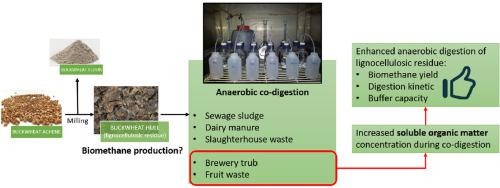Biomass & Bioenergy ( IF 6 ) Pub Date : 2021-08-14 , DOI: 10.1016/j.biombioe.2021.106209 Mirko Cucina 1 , Daniela Pezzolla 2 , Chiara Tacconi 2 , Giovanni Gigliotti 2

|
The aim of this paper was to deepen the knowledge of anaerobic co-digestion of lignocellulosic residues and evaluate the role of soluble organic matter during co-digestion. Buckwheat milling residue (buckwheat hull) was co-digested with different organic wastes to evaluate the effect of co-digestion on biomethane yield, process stability, and their relationship with soluble organic matter.
Results showed that co-digestion increased the biomethane yields of buckwheat hull and the best result was achieved from the co-digestion with slaughterhouse wastes (+254% of cumulative biomethane production). Kinetic analysis showed that fruit wastes and brewery trub affected positively anaerobic digestion of lignocellulosic residues, enhancing biomethane potential (+84% and +166%, respectively) and reducing lag phase duration. A positive correlation was found between the soluble organic matter and the biomethane yields during co-digestion experiments. Nevertheless, co-digestion with fruit wastes was affected by an excessive acidification in the early stage of AD (pH 5.7) caused by the rapid conversion of sugars into volatile fatty acids (7 g L-1 at day 15). Although all the digestates showed high concentrations of plant nutrients (the average content of total N was 7.8% dry weight), they were also characterized by residual phytotoxicity (germination index was always 0.0%). results.
Increasing the amount of easy biodegradable organic matter during lignocellulosic residues treatment should be the main goal when selecting co-digestion substrates. Chemical composition of co-digestion substrates should be carefully considered, with particular regard to soluble organic matter, to ensure the optimal development of anaerobic digestion with lignocellulosic residues.
中文翻译:

木质纤维素残渣与不同有机废物的厌氧共消化:生物甲烷产量、可溶性有机物和工艺稳定性之间的关系
本文的目的是加深对木质纤维素残留物厌氧共消化的认识,并评估可溶性有机物在共消化过程中的作用。荞麦碾磨残渣(荞麦壳)与不同的有机废物共同消化,以评估共同消化对生物甲烷产量、工艺稳定性的影响,以及它们与可溶性有机物的关系。
结果表明,共同消化增加了荞麦壳的生物甲烷产量,与屠宰场废物共同消化获得了最佳结果(+ 254% 的累积生物甲烷产量)。动力学分析表明,水果废料和啤酒厂残渣对木质纤维素残留物的厌氧消化产生了积极影响,提高了生物甲烷潜力(分别为 +84% 和 +166%)并减少了滞后期持续时间。在共消化实验中发现可溶性有机物质与生物甲烷产量之间呈正相关。然而,与水果废物的共同消化受到 AD 早期(pH 5.7)过度酸化的影响,这是由于糖快速转化为挥发性脂肪酸(7 g L -1在第 15 天)。尽管所有消化物都显示出高浓度的植物养分(总氮的平均含量为干重的 7.8%),但它们也具有残留的植物毒性(发芽指数始终为 0.0%)。结果。
在选择共消化底物时,增加木质纤维素残留物处理过程中易生物降解有机物的量应该是主要目标。应仔细考虑共消化底物的化学成分,尤其是可溶性有机物,以确保木质纤维素残留物厌氧消化的最佳发展。


























 京公网安备 11010802027423号
京公网安备 11010802027423号